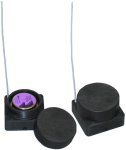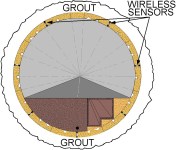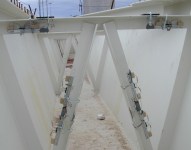Historical

The MicroWIS-XG system is a set of miniature wireless units that asynchronously transmit data to a receiver attached to a standard RS-232 port on a PC. The remote units are capable of interfacing with any type of resistive sensor: strain, temperature, pressure, humidity, etc.
The MicroWIS-XG system is an enhanced version of the original MicroWIS system developed for NASA in 1998.MicroWIS-XG is a cousin to and can operate in conjunction with both the MITE WIS™ and the ELMWIS™ systems.
A Graphical User Interface (GUI) provides immediate graphical representation of the data and storage in ASCII files. The XG GUI allows the user to select sample rates for each unit from 1 sample per hour to 1 sample per 4 seconds.
The enhancements to the XG system have not impacted the miniature size and include an improved communications protocol that allows the inclusion of additional sensor types, configurations, and data. Also included in XG is an improved error correction scheme.
MicroWIS-XG offers several options in packaging and battery sizes for a variety of applications.
- Sample Rate: 1/hour – 0.25Hz
- 1 channel per unit
- 100 units per system
- The units can support any resistive sensor type
- Approximate size: 3.3cm x 3.3cm x 1.5cm replaceable internal battery version
View the full MicroWIS-XG Technology Profile (MicroWIS-XG.pdf)

The original MicroWIS system is being used to monitor external grout pressure during construction of two tunnels in the Netherlands. Grout pressure determines the amount of grout that is deposited on the outside of the tunnel and is critical to the water-seal and durability of the tunnel. Click here for more information about this MicroWIS application.

In 2002 the original MicroWIS system was used to monitor the stresses on a bridge during the construction and testing phases because there were concerns that significant fatigue was induced during construction.
Click here for more information about this MicroWIS application.
